Detailed System Analysis and Design Report for Blanch Construction ERP
VerifiedAdded on 2023/05/30
|13
|1741
|80
Report
AI Summary
This report presents a comprehensive system analysis and design for an Enterprise Resource Planning (ERP) system tailored for Blanch Construction Company. It begins by defining both functional and non-functional requirements, utilizing the FURPS+ framework to cover aspects like functionality, usability, reliability, performance, and supportability. The report includes a detailed stakeholder analysis, classifying stakeholders into internal/external and executive/operational categories, accompanied by a stakeholder map and descriptions. A questionnaire targeting operational stakeholders is designed to gather system needs. Furthermore, the document outlines the system's data recording capabilities through a domain model class diagram, use case descriptions, a fully developed use case example (managing orders), use case diagram, activity diagram, and system sequence diagram. The analysis aims to provide a clear blueprint for the ERP system's development, ensuring it meets the specific needs of Blanch Construction Company. Desklib offers a wide range of similar documents and solved assignments for students.
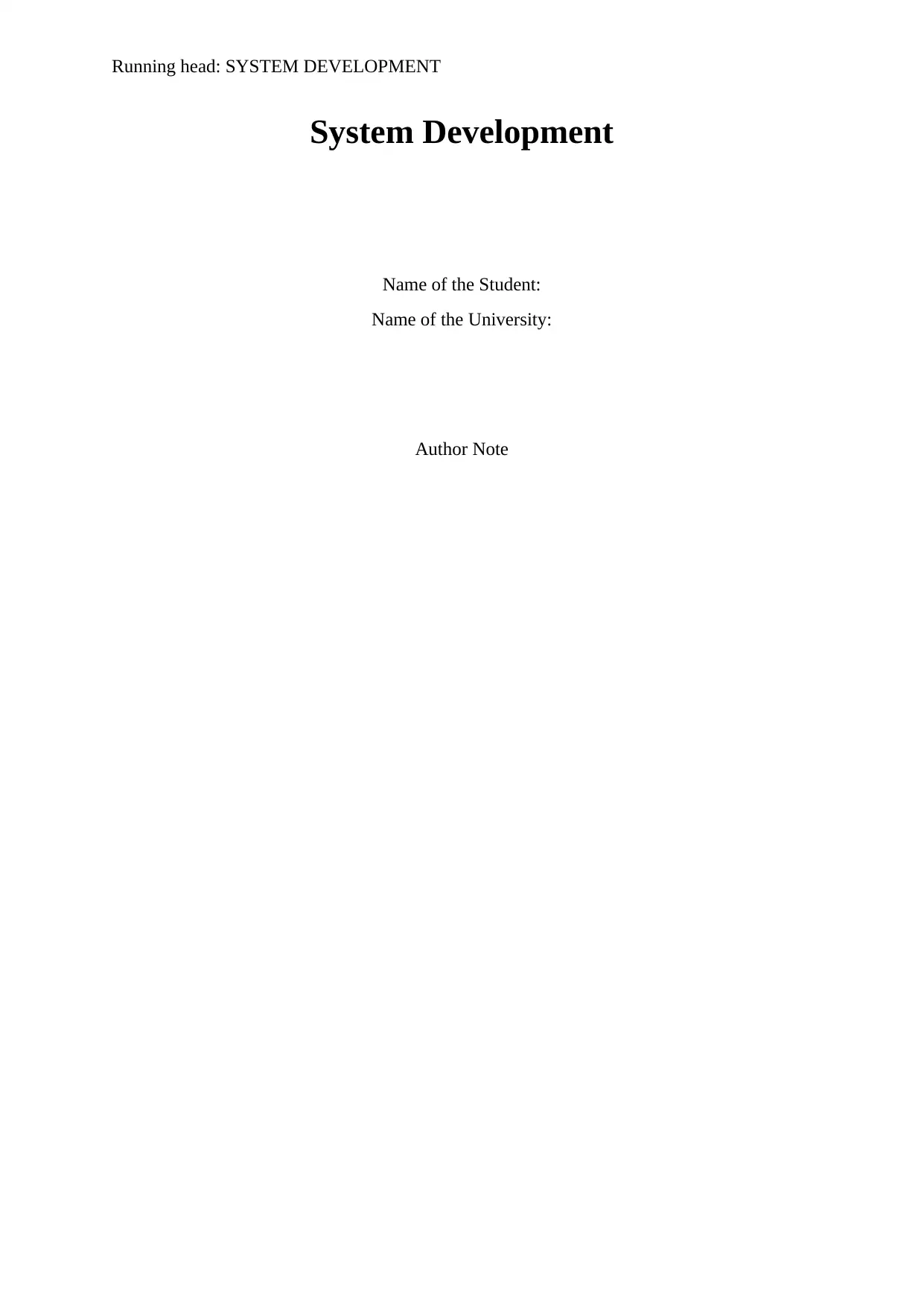
Running head: SYSTEM DEVELOPMENT
System Development
Name of the Student:
Name of the University:
Author Note
System Development
Name of the Student:
Name of the University:
Author Note
Paraphrase This Document
Need a fresh take? Get an instant paraphrase of this document with our AI Paraphraser
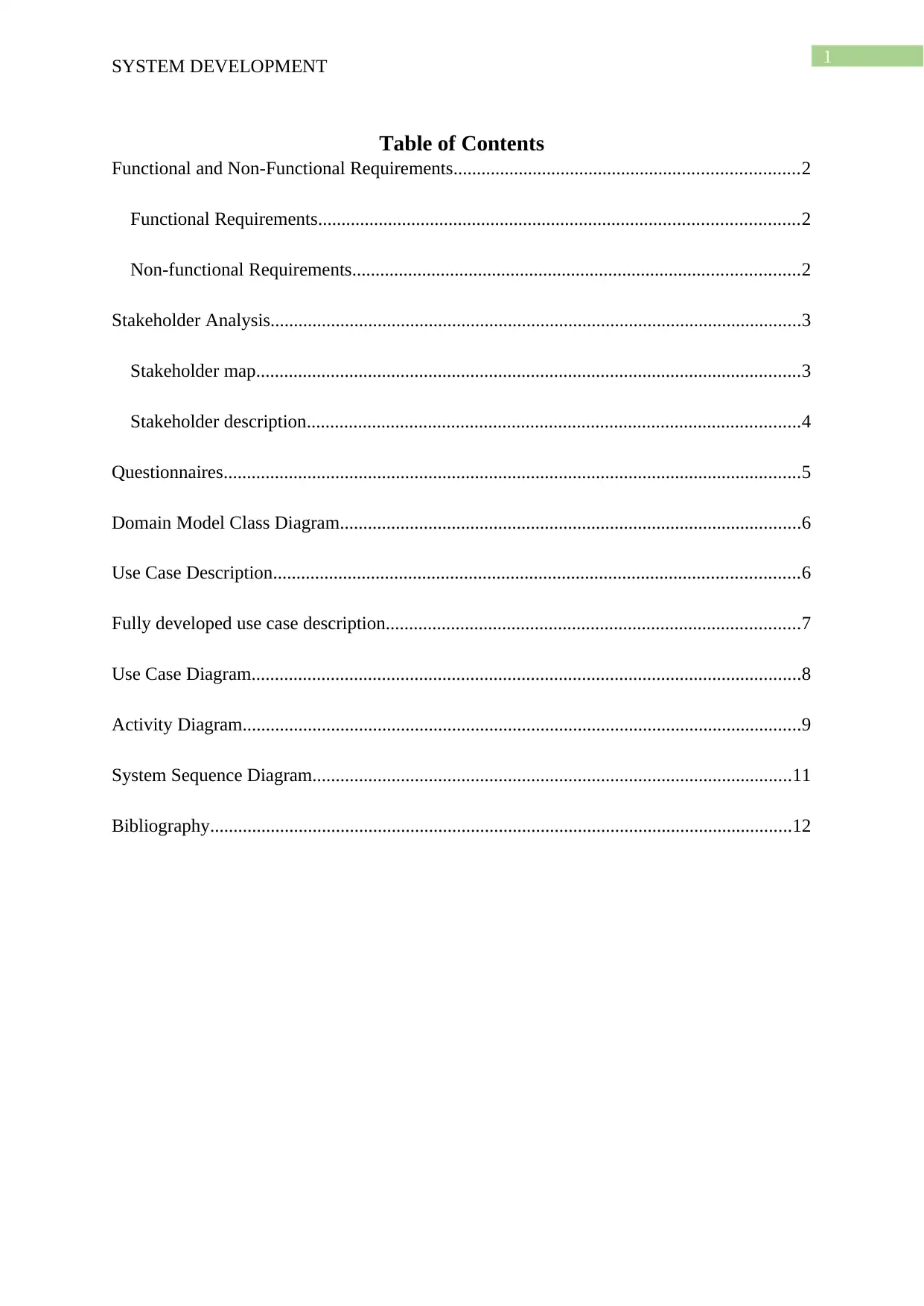
1
SYSTEM DEVELOPMENT
Table of Contents
Functional and Non-Functional Requirements..........................................................................2
Functional Requirements.......................................................................................................2
Non-functional Requirements................................................................................................2
Stakeholder Analysis..................................................................................................................3
Stakeholder map.....................................................................................................................3
Stakeholder description..........................................................................................................4
Questionnaires............................................................................................................................5
Domain Model Class Diagram...................................................................................................6
Use Case Description.................................................................................................................6
Fully developed use case description.........................................................................................7
Use Case Diagram......................................................................................................................8
Activity Diagram........................................................................................................................9
System Sequence Diagram.......................................................................................................11
Bibliography.............................................................................................................................12
SYSTEM DEVELOPMENT
Table of Contents
Functional and Non-Functional Requirements..........................................................................2
Functional Requirements.......................................................................................................2
Non-functional Requirements................................................................................................2
Stakeholder Analysis..................................................................................................................3
Stakeholder map.....................................................................................................................3
Stakeholder description..........................................................................................................4
Questionnaires............................................................................................................................5
Domain Model Class Diagram...................................................................................................6
Use Case Description.................................................................................................................6
Fully developed use case description.........................................................................................7
Use Case Diagram......................................................................................................................8
Activity Diagram........................................................................................................................9
System Sequence Diagram.......................................................................................................11
Bibliography.............................................................................................................................12
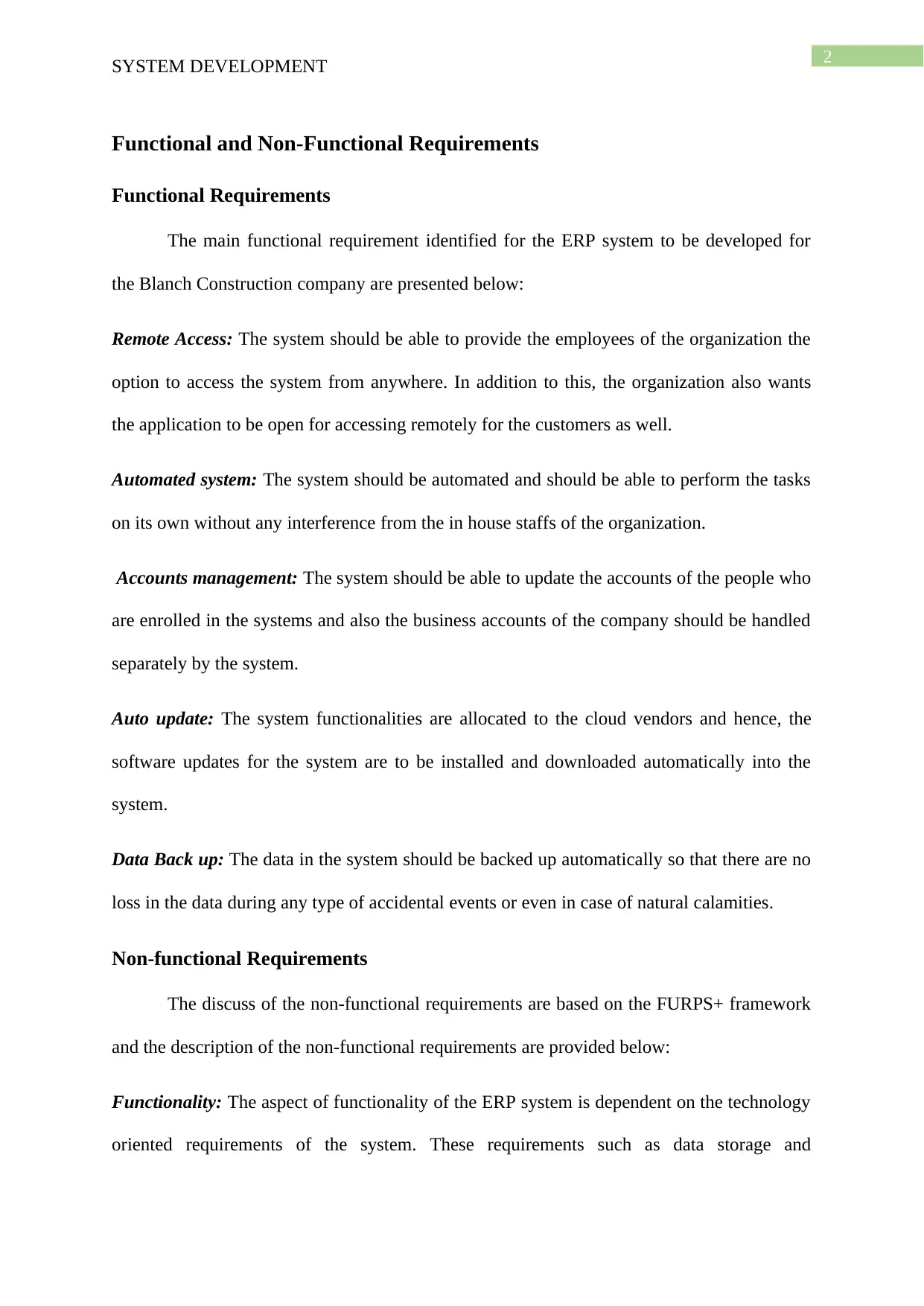
2
SYSTEM DEVELOPMENT
Functional and Non-Functional Requirements
Functional Requirements
The main functional requirement identified for the ERP system to be developed for
the Blanch Construction company are presented below:
Remote Access: The system should be able to provide the employees of the organization the
option to access the system from anywhere. In addition to this, the organization also wants
the application to be open for accessing remotely for the customers as well.
Automated system: The system should be automated and should be able to perform the tasks
on its own without any interference from the in house staffs of the organization.
Accounts management: The system should be able to update the accounts of the people who
are enrolled in the systems and also the business accounts of the company should be handled
separately by the system.
Auto update: The system functionalities are allocated to the cloud vendors and hence, the
software updates for the system are to be installed and downloaded automatically into the
system.
Data Back up: The data in the system should be backed up automatically so that there are no
loss in the data during any type of accidental events or even in case of natural calamities.
Non-functional Requirements
The discuss of the non-functional requirements are based on the FURPS+ framework
and the description of the non-functional requirements are provided below:
Functionality: The aspect of functionality of the ERP system is dependent on the technology
oriented requirements of the system. These requirements such as data storage and
SYSTEM DEVELOPMENT
Functional and Non-Functional Requirements
Functional Requirements
The main functional requirement identified for the ERP system to be developed for
the Blanch Construction company are presented below:
Remote Access: The system should be able to provide the employees of the organization the
option to access the system from anywhere. In addition to this, the organization also wants
the application to be open for accessing remotely for the customers as well.
Automated system: The system should be automated and should be able to perform the tasks
on its own without any interference from the in house staffs of the organization.
Accounts management: The system should be able to update the accounts of the people who
are enrolled in the systems and also the business accounts of the company should be handled
separately by the system.
Auto update: The system functionalities are allocated to the cloud vendors and hence, the
software updates for the system are to be installed and downloaded automatically into the
system.
Data Back up: The data in the system should be backed up automatically so that there are no
loss in the data during any type of accidental events or even in case of natural calamities.
Non-functional Requirements
The discuss of the non-functional requirements are based on the FURPS+ framework
and the description of the non-functional requirements are provided below:
Functionality: The aspect of functionality of the ERP system is dependent on the technology
oriented requirements of the system. These requirements such as data storage and
⊘ This is a preview!⊘
Do you want full access?
Subscribe today to unlock all pages.

Trusted by 1+ million students worldwide
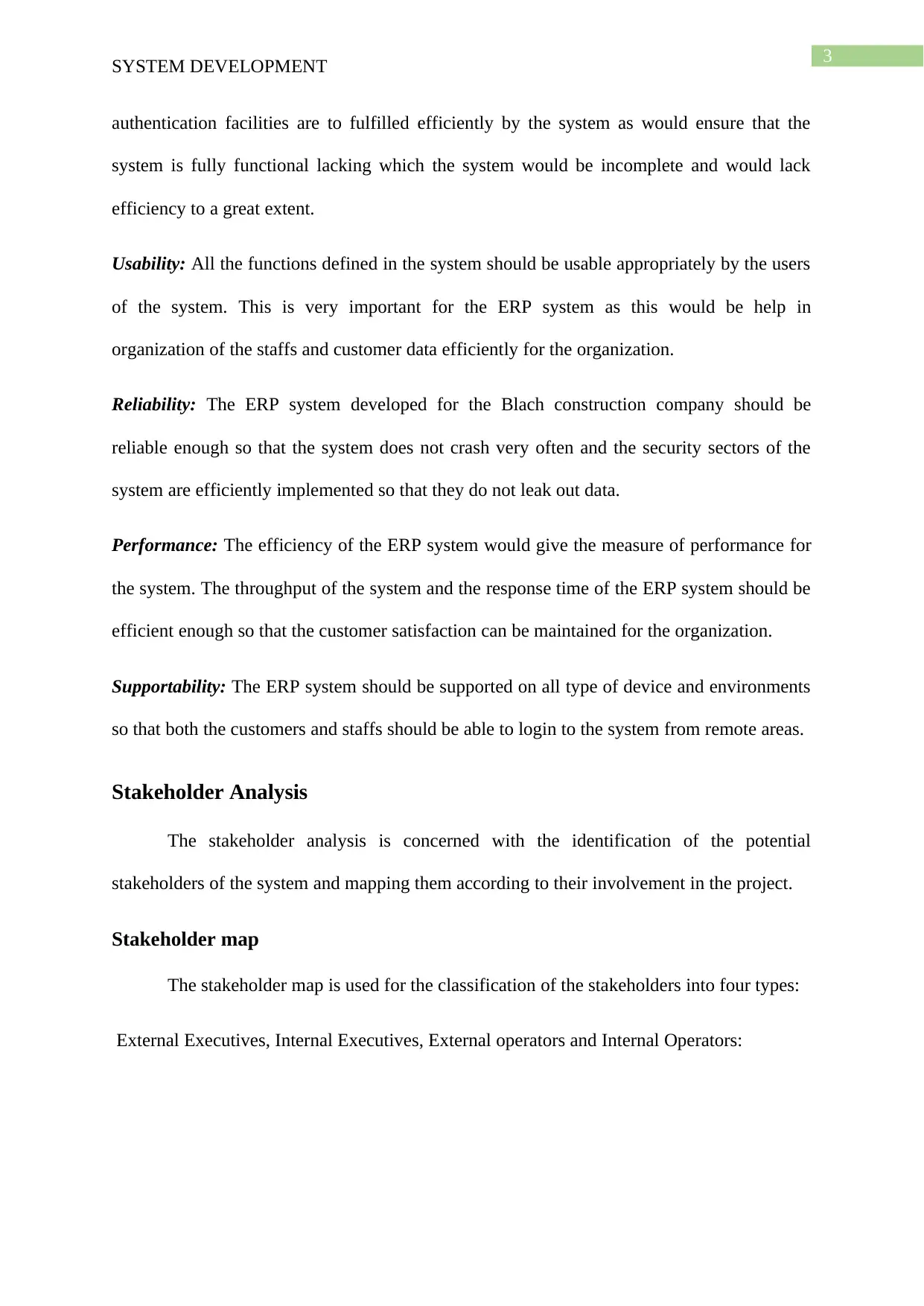
3
SYSTEM DEVELOPMENT
authentication facilities are to fulfilled efficiently by the system as would ensure that the
system is fully functional lacking which the system would be incomplete and would lack
efficiency to a great extent.
Usability: All the functions defined in the system should be usable appropriately by the users
of the system. This is very important for the ERP system as this would be help in
organization of the staffs and customer data efficiently for the organization.
Reliability: The ERP system developed for the Blach construction company should be
reliable enough so that the system does not crash very often and the security sectors of the
system are efficiently implemented so that they do not leak out data.
Performance: The efficiency of the ERP system would give the measure of performance for
the system. The throughput of the system and the response time of the ERP system should be
efficient enough so that the customer satisfaction can be maintained for the organization.
Supportability: The ERP system should be supported on all type of device and environments
so that both the customers and staffs should be able to login to the system from remote areas.
Stakeholder Analysis
The stakeholder analysis is concerned with the identification of the potential
stakeholders of the system and mapping them according to their involvement in the project.
Stakeholder map
The stakeholder map is used for the classification of the stakeholders into four types:
External Executives, Internal Executives, External operators and Internal Operators:
SYSTEM DEVELOPMENT
authentication facilities are to fulfilled efficiently by the system as would ensure that the
system is fully functional lacking which the system would be incomplete and would lack
efficiency to a great extent.
Usability: All the functions defined in the system should be usable appropriately by the users
of the system. This is very important for the ERP system as this would be help in
organization of the staffs and customer data efficiently for the organization.
Reliability: The ERP system developed for the Blach construction company should be
reliable enough so that the system does not crash very often and the security sectors of the
system are efficiently implemented so that they do not leak out data.
Performance: The efficiency of the ERP system would give the measure of performance for
the system. The throughput of the system and the response time of the ERP system should be
efficient enough so that the customer satisfaction can be maintained for the organization.
Supportability: The ERP system should be supported on all type of device and environments
so that both the customers and staffs should be able to login to the system from remote areas.
Stakeholder Analysis
The stakeholder analysis is concerned with the identification of the potential
stakeholders of the system and mapping them according to their involvement in the project.
Stakeholder map
The stakeholder map is used for the classification of the stakeholders into four types:
External Executives, Internal Executives, External operators and Internal Operators:
Paraphrase This Document
Need a fresh take? Get an instant paraphrase of this document with our AI Paraphraser
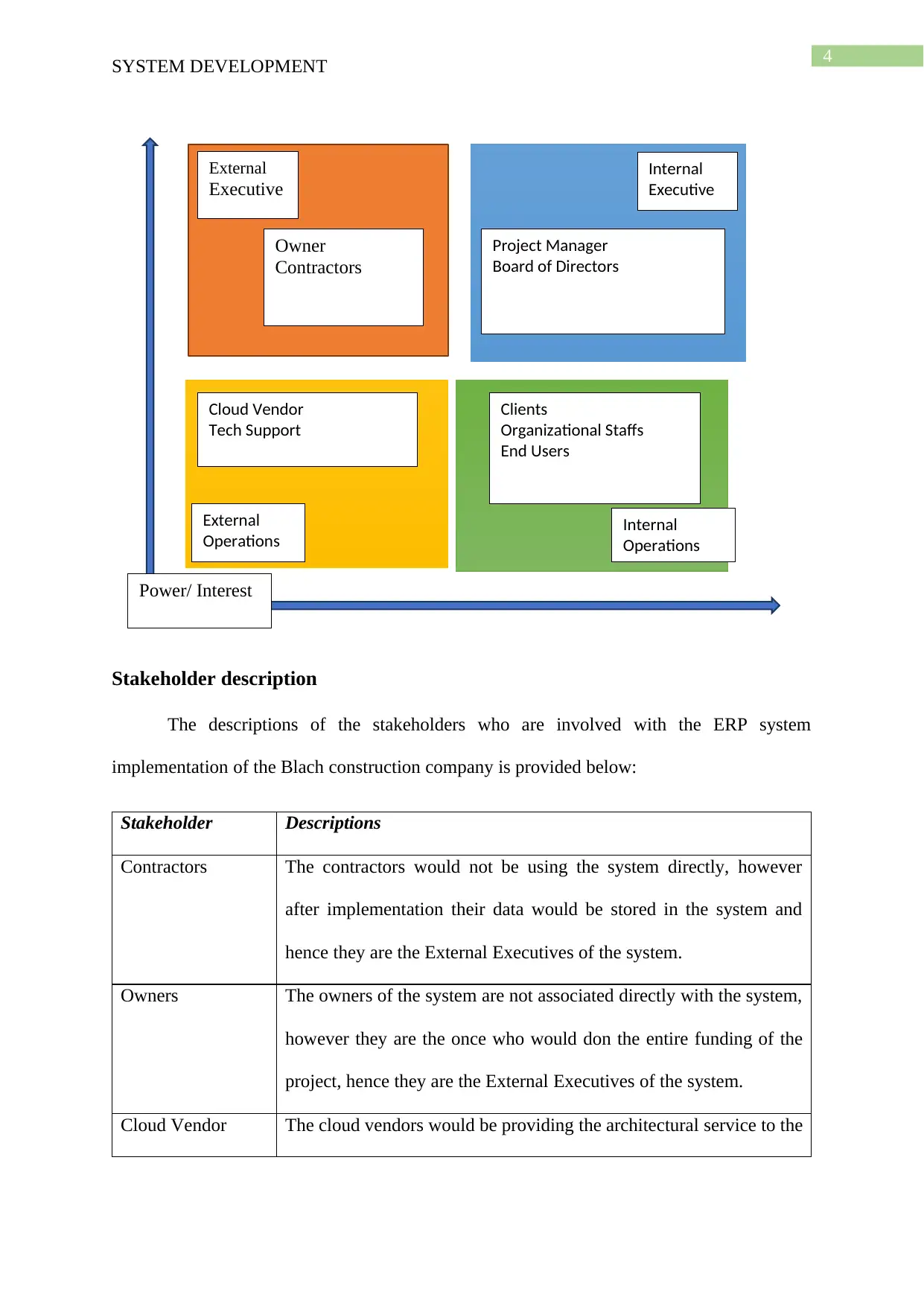
4
Power/ Interest
External
Executive
Internal
Executive
External
Operations Internal
Operations
Owner
Contractors
Project Manager
Board of Directors
Cloud Vendor
Tech Support
Clients
Organizational Staffs
End Users
SYSTEM DEVELOPMENT
Stakeholder description
The descriptions of the stakeholders who are involved with the ERP system
implementation of the Blach construction company is provided below:
Stakeholder Descriptions
Contractors The contractors would not be using the system directly, however
after implementation their data would be stored in the system and
hence they are the External Executives of the system.
Owners The owners of the system are not associated directly with the system,
however they are the once who would don the entire funding of the
project, hence they are the External Executives of the system.
Cloud Vendor The cloud vendors would be providing the architectural service to the
Power/ Interest
External
Executive
Internal
Executive
External
Operations Internal
Operations
Owner
Contractors
Project Manager
Board of Directors
Cloud Vendor
Tech Support
Clients
Organizational Staffs
End Users
SYSTEM DEVELOPMENT
Stakeholder description
The descriptions of the stakeholders who are involved with the ERP system
implementation of the Blach construction company is provided below:
Stakeholder Descriptions
Contractors The contractors would not be using the system directly, however
after implementation their data would be stored in the system and
hence they are the External Executives of the system.
Owners The owners of the system are not associated directly with the system,
however they are the once who would don the entire funding of the
project, hence they are the External Executives of the system.
Cloud Vendor The cloud vendors would be providing the architectural service to the
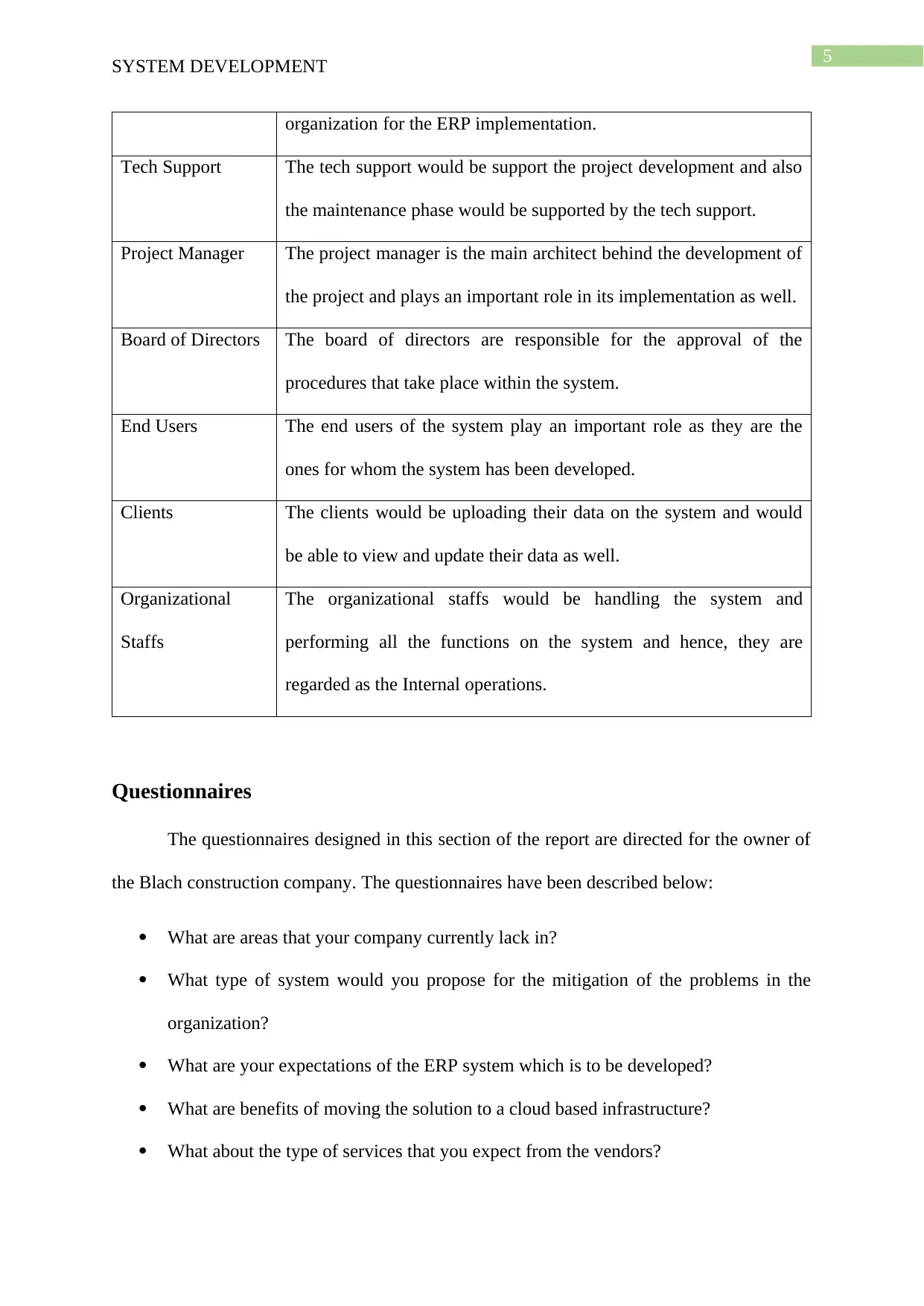
5
SYSTEM DEVELOPMENT
organization for the ERP implementation.
Tech Support The tech support would be support the project development and also
the maintenance phase would be supported by the tech support.
Project Manager The project manager is the main architect behind the development of
the project and plays an important role in its implementation as well.
Board of Directors The board of directors are responsible for the approval of the
procedures that take place within the system.
End Users The end users of the system play an important role as they are the
ones for whom the system has been developed.
Clients The clients would be uploading their data on the system and would
be able to view and update their data as well.
Organizational
Staffs
The organizational staffs would be handling the system and
performing all the functions on the system and hence, they are
regarded as the Internal operations.
Questionnaires
The questionnaires designed in this section of the report are directed for the owner of
the Blach construction company. The questionnaires have been described below:
What are areas that your company currently lack in?
What type of system would you propose for the mitigation of the problems in the
organization?
What are your expectations of the ERP system which is to be developed?
What are benefits of moving the solution to a cloud based infrastructure?
What about the type of services that you expect from the vendors?
SYSTEM DEVELOPMENT
organization for the ERP implementation.
Tech Support The tech support would be support the project development and also
the maintenance phase would be supported by the tech support.
Project Manager The project manager is the main architect behind the development of
the project and plays an important role in its implementation as well.
Board of Directors The board of directors are responsible for the approval of the
procedures that take place within the system.
End Users The end users of the system play an important role as they are the
ones for whom the system has been developed.
Clients The clients would be uploading their data on the system and would
be able to view and update their data as well.
Organizational
Staffs
The organizational staffs would be handling the system and
performing all the functions on the system and hence, they are
regarded as the Internal operations.
Questionnaires
The questionnaires designed in this section of the report are directed for the owner of
the Blach construction company. The questionnaires have been described below:
What are areas that your company currently lack in?
What type of system would you propose for the mitigation of the problems in the
organization?
What are your expectations of the ERP system which is to be developed?
What are benefits of moving the solution to a cloud based infrastructure?
What about the type of services that you expect from the vendors?
⊘ This is a preview!⊘
Do you want full access?
Subscribe today to unlock all pages.

Trusted by 1+ million students worldwide
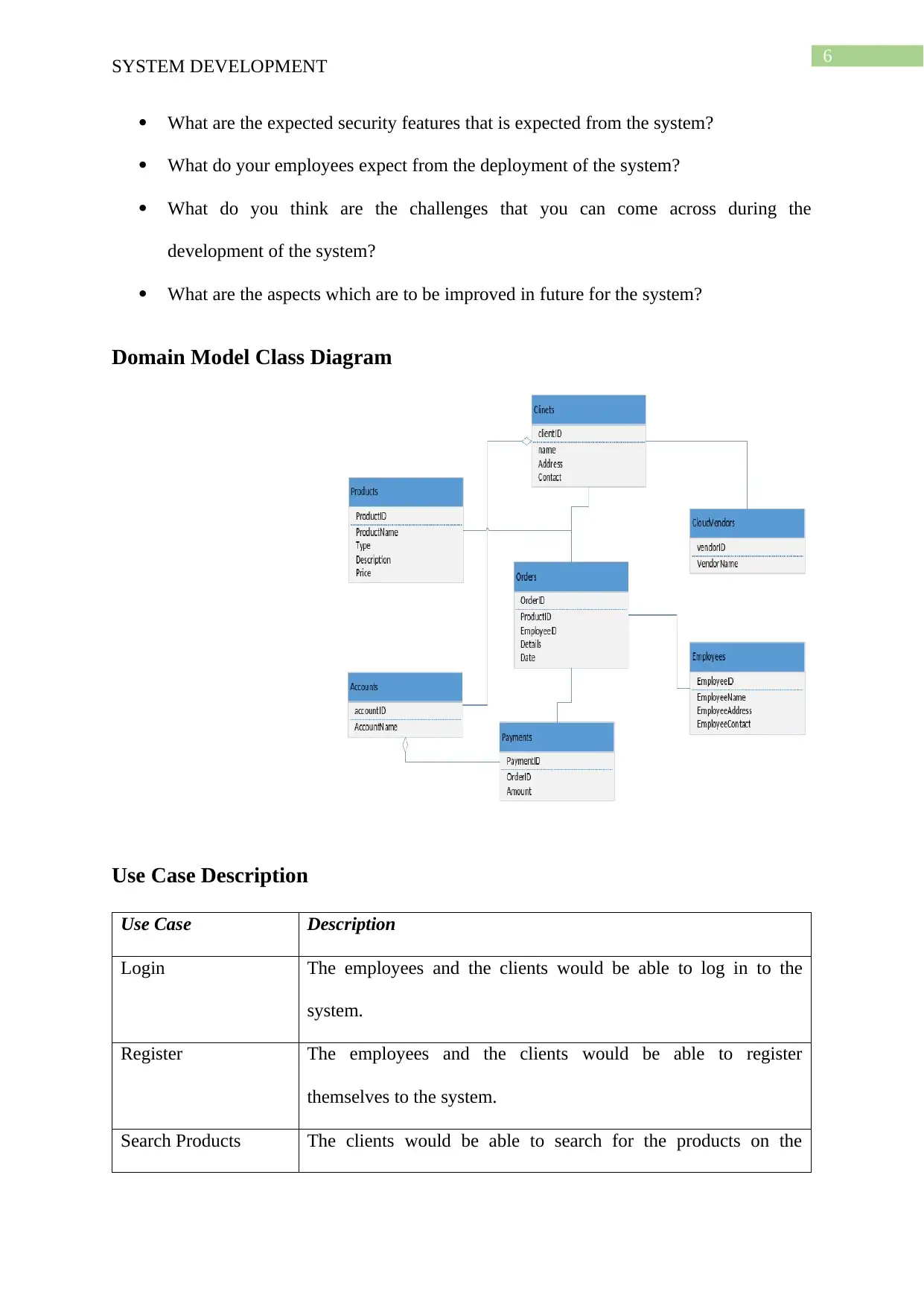
6
SYSTEM DEVELOPMENT
What are the expected security features that is expected from the system?
What do your employees expect from the deployment of the system?
What do you think are the challenges that you can come across during the
development of the system?
What are the aspects which are to be improved in future for the system?
Domain Model Class Diagram
Use Case Description
Use Case Description
Login The employees and the clients would be able to log in to the
system.
Register The employees and the clients would be able to register
themselves to the system.
Search Products The clients would be able to search for the products on the
SYSTEM DEVELOPMENT
What are the expected security features that is expected from the system?
What do your employees expect from the deployment of the system?
What do you think are the challenges that you can come across during the
development of the system?
What are the aspects which are to be improved in future for the system?
Domain Model Class Diagram
Use Case Description
Use Case Description
Login The employees and the clients would be able to log in to the
system.
Register The employees and the clients would be able to register
themselves to the system.
Search Products The clients would be able to search for the products on the
Paraphrase This Document
Need a fresh take? Get an instant paraphrase of this document with our AI Paraphraser
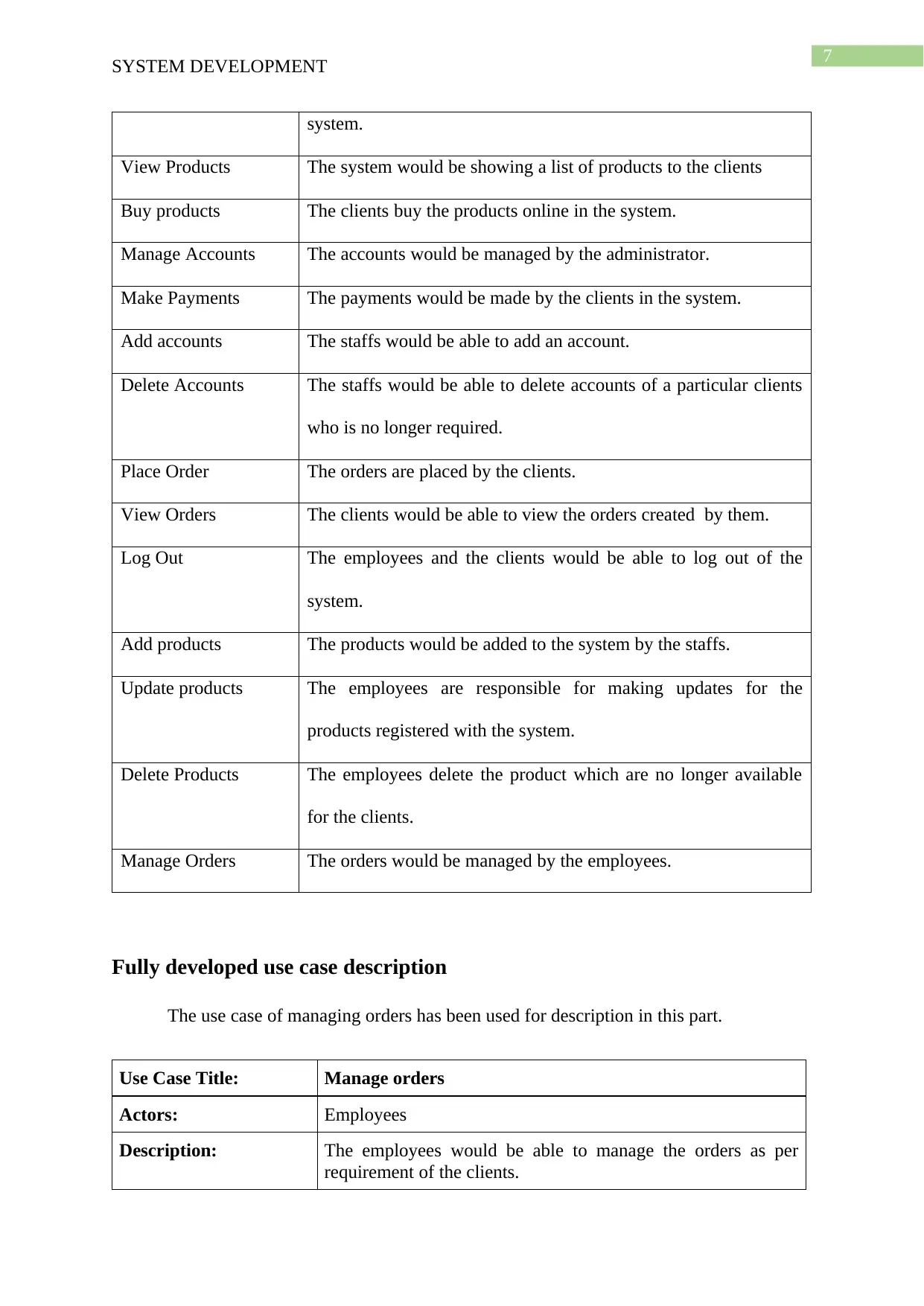
7
SYSTEM DEVELOPMENT
system.
View Products The system would be showing a list of products to the clients
Buy products The clients buy the products online in the system.
Manage Accounts The accounts would be managed by the administrator.
Make Payments The payments would be made by the clients in the system.
Add accounts The staffs would be able to add an account.
Delete Accounts The staffs would be able to delete accounts of a particular clients
who is no longer required.
Place Order The orders are placed by the clients.
View Orders The clients would be able to view the orders created by them.
Log Out The employees and the clients would be able to log out of the
system.
Add products The products would be added to the system by the staffs.
Update products The employees are responsible for making updates for the
products registered with the system.
Delete Products The employees delete the product which are no longer available
for the clients.
Manage Orders The orders would be managed by the employees.
Fully developed use case description
The use case of managing orders has been used for description in this part.
Use Case Title: Manage orders
Actors: Employees
Description: The employees would be able to manage the orders as per
requirement of the clients.
SYSTEM DEVELOPMENT
system.
View Products The system would be showing a list of products to the clients
Buy products The clients buy the products online in the system.
Manage Accounts The accounts would be managed by the administrator.
Make Payments The payments would be made by the clients in the system.
Add accounts The staffs would be able to add an account.
Delete Accounts The staffs would be able to delete accounts of a particular clients
who is no longer required.
Place Order The orders are placed by the clients.
View Orders The clients would be able to view the orders created by them.
Log Out The employees and the clients would be able to log out of the
system.
Add products The products would be added to the system by the staffs.
Update products The employees are responsible for making updates for the
products registered with the system.
Delete Products The employees delete the product which are no longer available
for the clients.
Manage Orders The orders would be managed by the employees.
Fully developed use case description
The use case of managing orders has been used for description in this part.
Use Case Title: Manage orders
Actors: Employees
Description: The employees would be able to manage the orders as per
requirement of the clients.
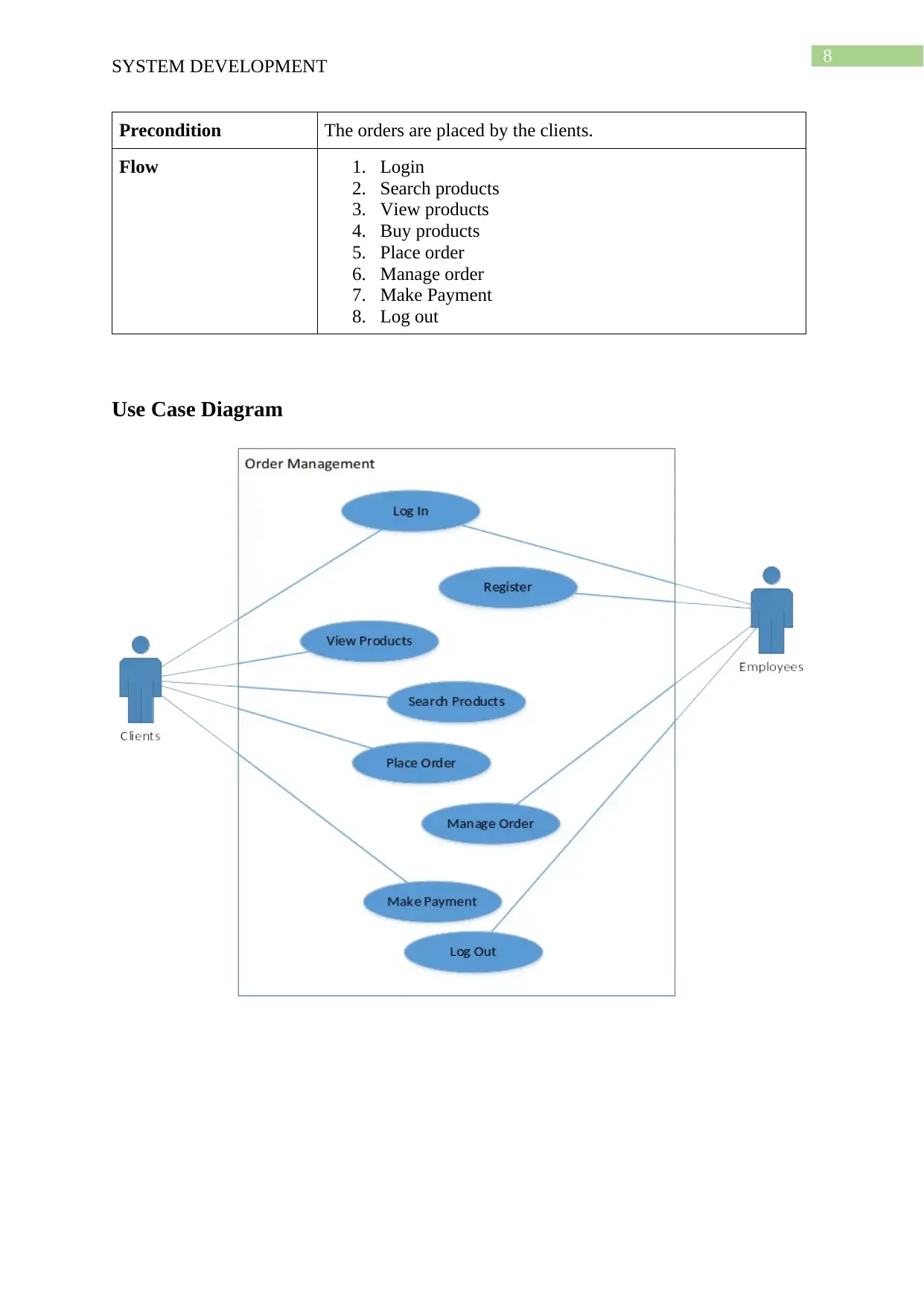
8
SYSTEM DEVELOPMENT
Precondition The orders are placed by the clients.
Flow 1. Login
2. Search products
3. View products
4. Buy products
5. Place order
6. Manage order
7. Make Payment
8. Log out
Use Case Diagram
SYSTEM DEVELOPMENT
Precondition The orders are placed by the clients.
Flow 1. Login
2. Search products
3. View products
4. Buy products
5. Place order
6. Manage order
7. Make Payment
8. Log out
Use Case Diagram
⊘ This is a preview!⊘
Do you want full access?
Subscribe today to unlock all pages.

Trusted by 1+ million students worldwide
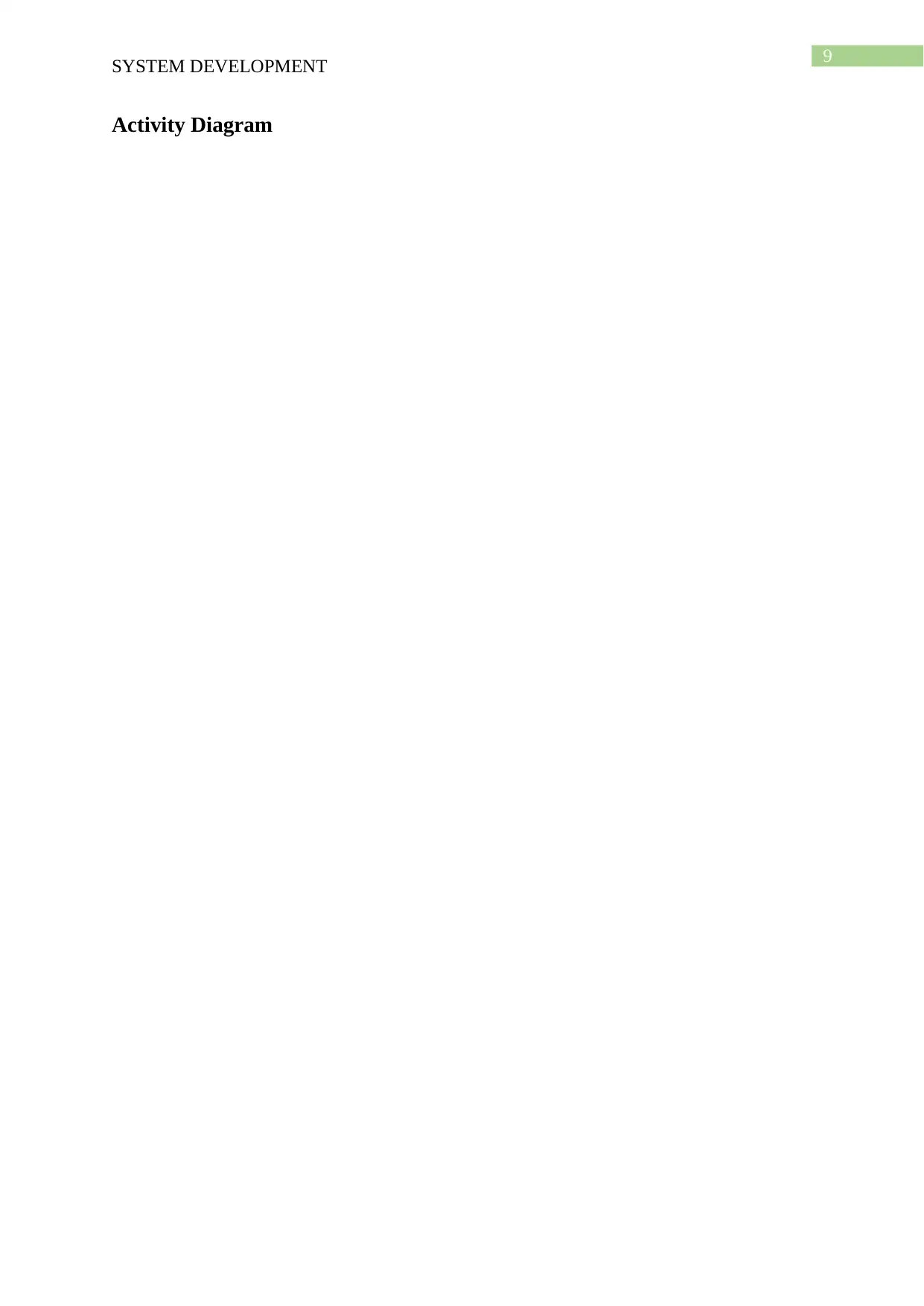
9
SYSTEM DEVELOPMENT
Activity Diagram
SYSTEM DEVELOPMENT
Activity Diagram
Paraphrase This Document
Need a fresh take? Get an instant paraphrase of this document with our AI Paraphraser
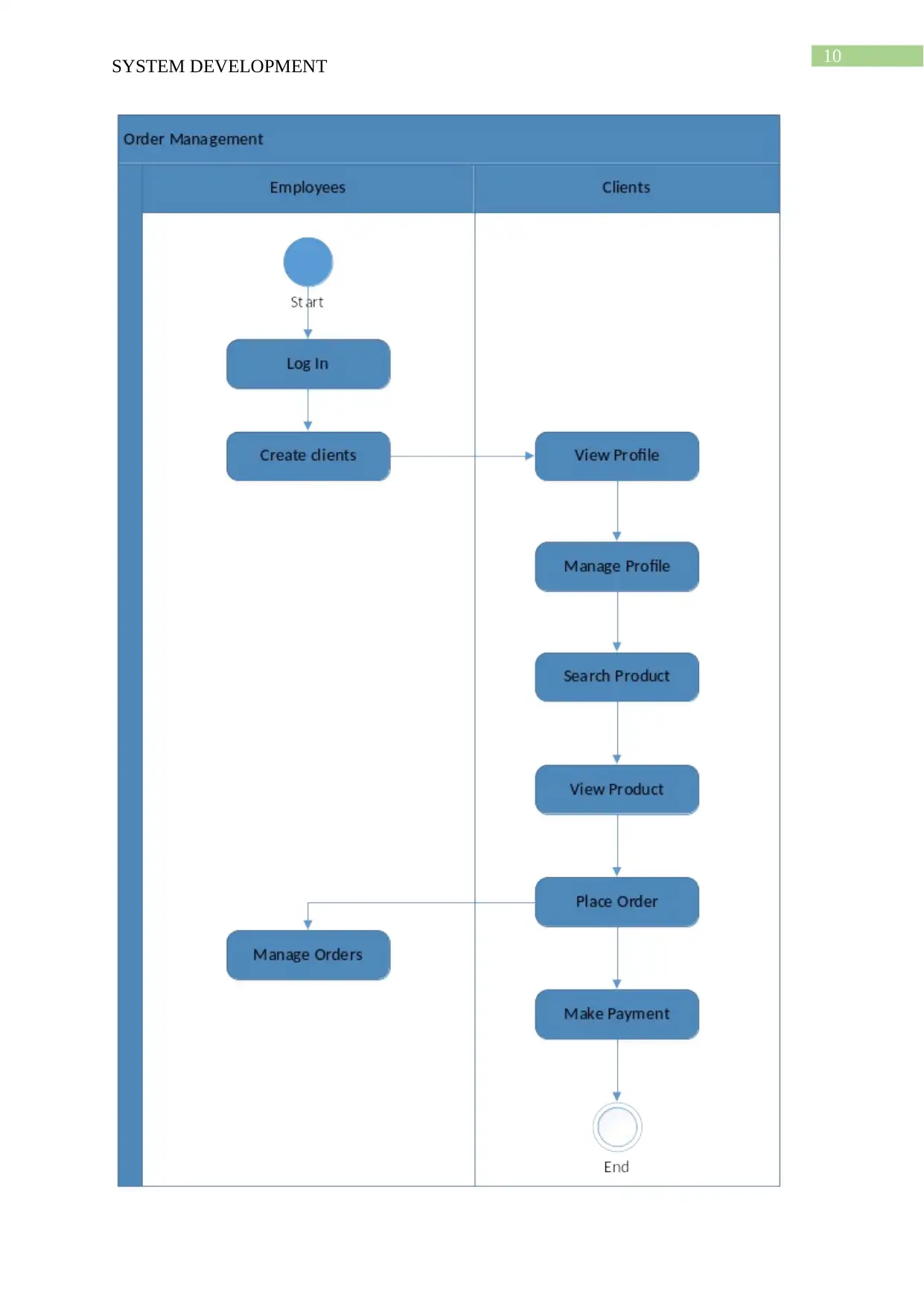
10
SYSTEM DEVELOPMENT
SYSTEM DEVELOPMENT
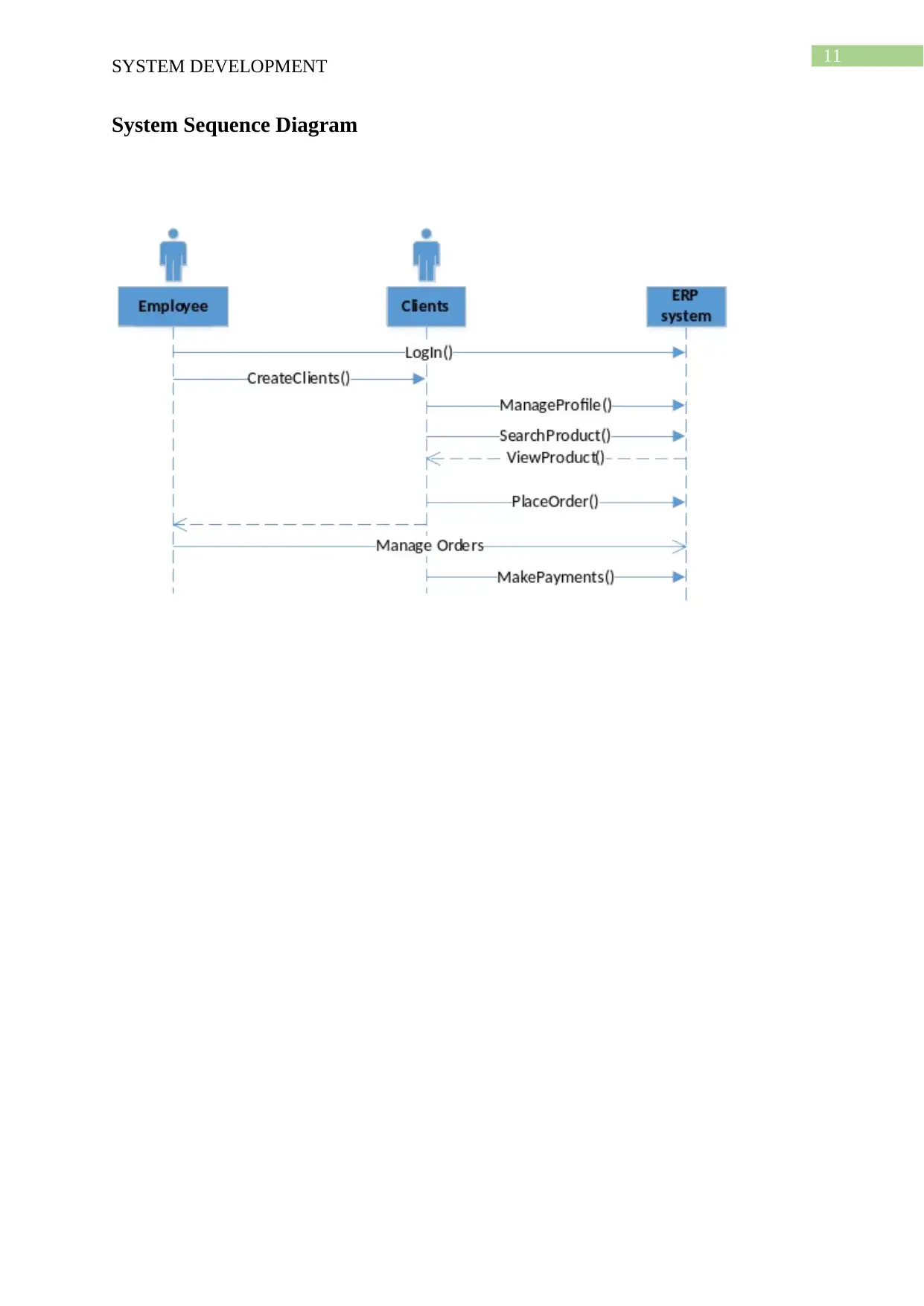
11
SYSTEM DEVELOPMENT
System Sequence Diagram
SYSTEM DEVELOPMENT
System Sequence Diagram
⊘ This is a preview!⊘
Do you want full access?
Subscribe today to unlock all pages.

Trusted by 1+ million students worldwide
1 out of 13
Related Documents
Your All-in-One AI-Powered Toolkit for Academic Success.
+13062052269
info@desklib.com
Available 24*7 on WhatsApp / Email
![[object Object]](/_next/static/media/star-bottom.7253800d.svg)
Unlock your academic potential
Copyright © 2020–2025 A2Z Services. All Rights Reserved. Developed and managed by ZUCOL.





